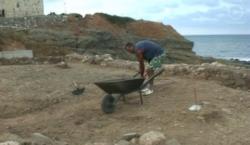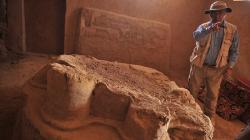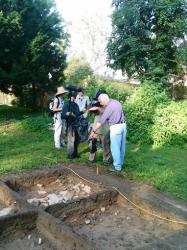INSTITUT SUPERIEUR D'ANTHROPOLOGIE
INSTITUTE OF ANTHROPOLOGY
ONLINE COURSES / COURS A DISTANCE
INSCRIPTION : Année Universitaire 2012/2013
REGISTRATION : Academic Year 2012 / 2013
BULGARIE –  Tsarevo - Archaeologists have discovered a Thracian settlement during the first ever excavations in the town of Tsarevo on the southern Black Sea coast. The team is led by Milen Nikolov, an archaeologist from the Regional History Museum in the Black Sea city of Burgas. The settlement is very close in location to the town church "Uspenie Bogorodichno." The find proves that Tsarevo and nearby areas have a history more ancient that what was believed until now. During the excavations, the archaeologists have found remnants showing that as early as the 4th – 5th century BC Thracians have built a town that existed until the 1st century AC. Nikolov explains the discovery is a 2 500-year history rewind, saying the finds further include a four-wick lamp, tomb gifts, and a number of vessels.
Tsarevo - Archaeologists have discovered a Thracian settlement during the first ever excavations in the town of Tsarevo on the southern Black Sea coast. The team is led by Milen Nikolov, an archaeologist from the Regional History Museum in the Black Sea city of Burgas. The settlement is very close in location to the town church "Uspenie Bogorodichno." The find proves that Tsarevo and nearby areas have a history more ancient that what was believed until now. During the excavations, the archaeologists have found remnants showing that as early as the 4th – 5th century BC Thracians have built a town that existed until the 1st century AC. Nikolov explains the discovery is a 2 500-year history rewind, saying the finds further include a four-wick lamp, tomb gifts, and a number of vessels.
http://www.novinite.com/view_news.php?id=142284
COSTA RICA –  Ile Cocos - An engineer is hoping 21st century technology will uncover the "Loot of Lima" treasure which has eluded generations of adventurers. Shaun Whitehead is leading an archaeological expedition to try to uncover treasure buried on the Pacific island of Cocos, off the coast of Costa Rica, worth an estimated £160 million. The haul could contain 113 gold religious statues, 200 chests of jewels, 273 swords with jewelled hilts, 1,000 diamonds, gold crowns, 150 chalices and hundreds of gold and silver bars. The team plans to use a small, unmanned helicopter drone, fitted with cameras, to fly above the nine square mile island to make a computer-generated 3D map of the landscape. A snake-like robot will be dragged across likely hotspots and will use radar to detect voids and cavities up to a depth of 60 feet. The information will be combined with the map to identify caves that have been covered by landslides. Once possible spots have been selected, a drill will drive through up to 100 feet of soil and a one inch-wide probe camera will be sent down. The 10-day expedition, which will take place between December and March, will involve extensive archaeological, geological and ecological research. Mr Whitehead said the quest was not specifically for treasure, but also to carry out the ecological, geological and archaeological research. Mr Whitehead, whose engineering company Scoutek provides and operates specialist electronic exploration equipment, said: "I like to call it keyhole archaeology which is minimally invasive and allows us to take a peek into some of those caves which have lain undisturbed for 200 years."
Ile Cocos - An engineer is hoping 21st century technology will uncover the "Loot of Lima" treasure which has eluded generations of adventurers. Shaun Whitehead is leading an archaeological expedition to try to uncover treasure buried on the Pacific island of Cocos, off the coast of Costa Rica, worth an estimated £160 million. The haul could contain 113 gold religious statues, 200 chests of jewels, 273 swords with jewelled hilts, 1,000 diamonds, gold crowns, 150 chalices and hundreds of gold and silver bars. The team plans to use a small, unmanned helicopter drone, fitted with cameras, to fly above the nine square mile island to make a computer-generated 3D map of the landscape. A snake-like robot will be dragged across likely hotspots and will use radar to detect voids and cavities up to a depth of 60 feet. The information will be combined with the map to identify caves that have been covered by landslides. Once possible spots have been selected, a drill will drive through up to 100 feet of soil and a one inch-wide probe camera will be sent down. The 10-day expedition, which will take place between December and March, will involve extensive archaeological, geological and ecological research. Mr Whitehead said the quest was not specifically for treasure, but also to carry out the ecological, geological and archaeological research. Mr Whitehead, whose engineering company Scoutek provides and operates specialist electronic exploration equipment, said: "I like to call it keyhole archaeology which is minimally invasive and allows us to take a peek into some of those caves which have lain undisturbed for 200 years."
http://www.thisisleicestershire.co.uk/Shaun-hunting-pound-160m-treasure/story-16704933-detail/story.html
ROYAUME UNI - Achill-henge - London-based researcher Richard Brock has issued a plea to halt the planned destruction of the controversial Achill-henge on the grounds of its potential as a site for experimental archaeological research. Joe McNamara, the man behind the Stonehenge replica, has been ordered to remove it. On July 26, An Bord Pleanála (ABP) ruled that the structure, which sits on a hilltop overlooking the villages of Pollagh and Keel, was not exempted development. The High Court subsequently lifted its stay on an earlier demolition order, which was in place until the ABP made its decision. However, Richard Brock, a classically-trained musician and computer scientist with a long interest in the archaeology of Stonehenge, is convinced that the acoustic properties of the Achill structure could yield valuable clues to musical archaeologists, and he is appealing for its retention.
Having carried out preliminary tests on site in recent days, he is satisfied that echoes of sounds made in the centre of the mass-concrete circle create a dome of sound in much the same manner as the original Stonehenge. “Achill-henge is much easier to access for European researchers, is better constructed than the Maryhill version and could become a key site in the growing field of archaeoacoustics,” Brock said. The Maryhill site was built in 1929 as a World War I memorial, and its surfaces are quite rough. In addition, it is not on an upland site in the same way as Achill-henge is, giving additional opportunities for studying acoustic effects. Archaeoacoustics is a branch of music archaeology, which has moved on from trying to recreate the sound of ancient instruments to trying to understand how they sounded in their original contexts, and whether the ancient monuments could have been designed with musical effects in mind.
http://www.mayonews.ie/index.php?option=com_content&view=article&id=15914:british-researcher-pitches-for-achill-henge&catid=23:news&Itemid=46
AFGHANISTAN –  Bamiyan - "It’s there," says an archaeologist pointing to the ground, where fragments of a Buddha statue from the ancient Gandhara civilisation have been covered up to stop them being stolen or vandalised. Just months before the US-led invasion in 2001, the Taliban regime shocked the world by destroying two giant, 1500-year-old Buddhas in the rocky Bamiyan valley, branding them un-Islamic. At the foot of the cliff where the two Buddhas used to stand 130 kilometres west of Kabul, an archaeological site has been found and parts of a third Buddha, lying down, were discovered in 2008. The area of the lying Buddha is around half the size of a football pitch. A dozen statues or more lie under tonnes of stone and earth. "We covered everything up because the ground is private and to prevent looting," says Zemaryalai Tarzi, the 75-year-old French archaeologist born in Afghanistan who is leading the project.
Bamiyan - "It’s there," says an archaeologist pointing to the ground, where fragments of a Buddha statue from the ancient Gandhara civilisation have been covered up to stop them being stolen or vandalised. Just months before the US-led invasion in 2001, the Taliban regime shocked the world by destroying two giant, 1500-year-old Buddhas in the rocky Bamiyan valley, branding them un-Islamic. At the foot of the cliff where the two Buddhas used to stand 130 kilometres west of Kabul, an archaeological site has been found and parts of a third Buddha, lying down, were discovered in 2008. The area of the lying Buddha is around half the size of a football pitch. A dozen statues or more lie under tonnes of stone and earth. "We covered everything up because the ground is private and to prevent looting," says Zemaryalai Tarzi, the 75-year-old French archaeologist born in Afghanistan who is leading the project.
http://www.perthnow.com.au/news/world/archaeologists-leave-artefacts-underground-to-protect-them-from-the-taliban/story-fnd14032-1226448798599
USA –  Bethesda - Archaeologists have discovered what they think are remains of a barn or blacksmith workshop in North Bethesda that could date to the days of Josiah Henson, a former slave whose autobiography inspired the novel "Uncle Tom's Cabin." Looking for evidence of what slave life in Maryland was like, archaeologists with the Maryland-National Capital Park and Planning Commission Montgomery Parks and the PBS program "Time Team America" began exploring the Josiah Henson Special Park on Monday. They found evidence of a buried foundation that may have existed in the late 1700s and early 1800s, when Henson worked on the homestead for landowner Isaac Riley.
Bethesda - Archaeologists have discovered what they think are remains of a barn or blacksmith workshop in North Bethesda that could date to the days of Josiah Henson, a former slave whose autobiography inspired the novel "Uncle Tom's Cabin." Looking for evidence of what slave life in Maryland was like, archaeologists with the Maryland-National Capital Park and Planning Commission Montgomery Parks and the PBS program "Time Team America" began exploring the Josiah Henson Special Park on Monday. They found evidence of a buried foundation that may have existed in the late 1700s and early 1800s, when Henson worked on the homestead for landowner Isaac Riley.
http://articles.baltimoresun.com/2012-08-13/health/bs-md-josiah-henson-dig-20120813_1_isaac-riley-josiah-henson-archaeology
BULGARIE -  Perperikon - Bulgarian archaeologists expect to find at the holy rock city of Perperikon the largest ever medieval coin treasure in the country. The announcement was made by leading Bulgarian archaeologist, Prof. Nikolay Ovcharov, after his team recently found a total 11 gold and 6 silver coins. The gold coins are from the 14th century while the silver ones are from the end of the 13th century. The coins have been found dispersed in what has been used as a toilet hole with a 2-meter diameter, leading the experts to believe that they were hidden and buried during the Ottoman invasion of the area. Such treasures were usually placed in clay pots or similar vessels and then concealed, while for the latest find it is believed that the coins were put in some sort of a purse, which has decomposed over the years. The coins were found in the central town of Perperikon, near the Citadel, in the area believed to have been the residence of the very wealthy bishops. Ovcharov says the excavations there are continuing with expectations to discover more than 50 other gold coins. The latest finds also include an intricate silver frame of a still-undated icon. There is ongoing research at the two churches in the southeast area of the Acropolis while two tombs, most likely bishop ones, will be opened next week. The unique Ancient Thracian city of Perperikon was first discovered in 1979 in the Eastern Rhodoppe Mountains. It is thought that the famous sanctuary and oracular shrine dedicated to Dionysus of the Bessi tribe was situated there. The ancient rock city contains remains from all archaeological periods. Ovcharov also discovered nearby an ancient Thracian surface tomb in the village ofTatul, containing a sanctuary linked with the cult of Orpheus.
Perperikon - Bulgarian archaeologists expect to find at the holy rock city of Perperikon the largest ever medieval coin treasure in the country. The announcement was made by leading Bulgarian archaeologist, Prof. Nikolay Ovcharov, after his team recently found a total 11 gold and 6 silver coins. The gold coins are from the 14th century while the silver ones are from the end of the 13th century. The coins have been found dispersed in what has been used as a toilet hole with a 2-meter diameter, leading the experts to believe that they were hidden and buried during the Ottoman invasion of the area. Such treasures were usually placed in clay pots or similar vessels and then concealed, while for the latest find it is believed that the coins were put in some sort of a purse, which has decomposed over the years. The coins were found in the central town of Perperikon, near the Citadel, in the area believed to have been the residence of the very wealthy bishops. Ovcharov says the excavations there are continuing with expectations to discover more than 50 other gold coins. The latest finds also include an intricate silver frame of a still-undated icon. There is ongoing research at the two churches in the southeast area of the Acropolis while two tombs, most likely bishop ones, will be opened next week. The unique Ancient Thracian city of Perperikon was first discovered in 1979 in the Eastern Rhodoppe Mountains. It is thought that the famous sanctuary and oracular shrine dedicated to Dionysus of the Bessi tribe was situated there. The ancient rock city contains remains from all archaeological periods. Ovcharov also discovered nearby an ancient Thracian surface tomb in the village ofTatul, containing a sanctuary linked with the cult of Orpheus.
http://www.novinite.com/view_news.php?id=142282